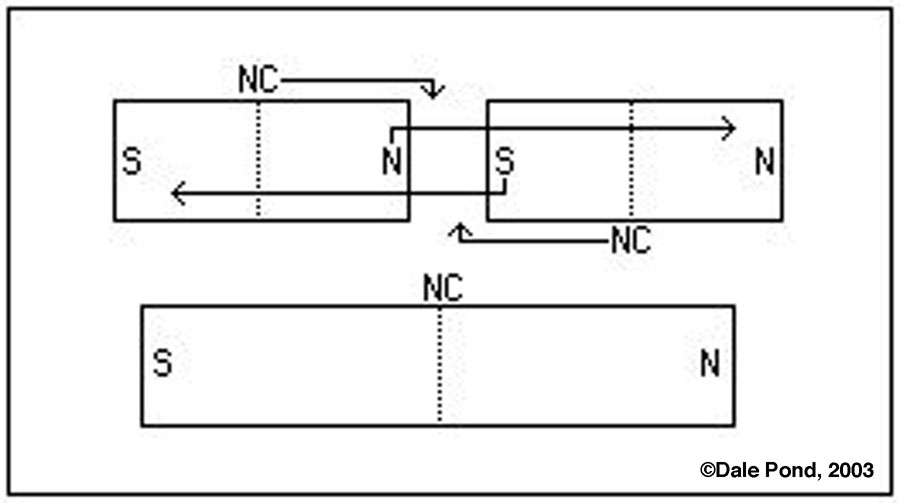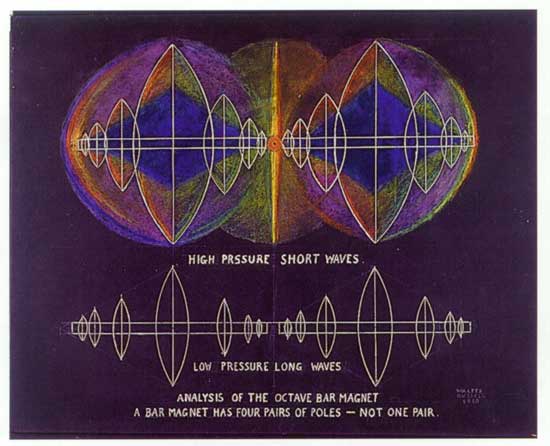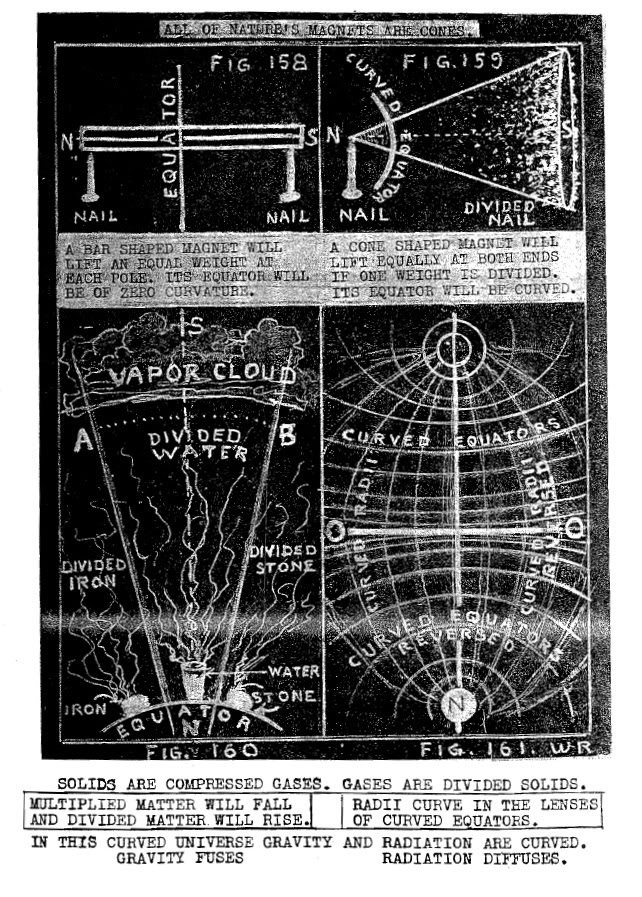"In both Electricity and magnetism there are the two opposite forces, the positive and the negative. In both, the two forces attract each other, and each repels its kind. In Electricity the two are never present in the same body. In both there is between the two forces a "NEUTRAL FORCE," which places itself, in Electricity, as a resistant wall between two opposing clouds, or a positive cloud and the magnetic earth. In a magnet, where the two forces are always present actively in the one substance, the neutral appears midway in the substance; separating the two, and thus preventing their blending with and neutralizing each other. In the natural magnet the equator shows neither attraction nor repulsion, because the attractive power of each ingredient of the natural is rendered inoperative by the presence of the other." [Seth Pancoast; The True Science of Light] (emphasis added)

The neutral center is the point of dispersion or redistribution of each of the two bar magnets. Polarized activity is repelled or pushed away from this center of high harmonicity. Like and unlike poles do not repel each other. The neutral center of each combine and moves to the center of them both when joined. Seeming repulsion is a result of differentiation of/in sympathy, ala Bjerknes Effect. The poles, when the magnetic is doubled, migrate to the ends demonstrating magnetism is not an attribute of the iron but is an attribute of magnetic flow proper. See also Part 14, Part 16 and Sympathetic Outreach.

See Howard Johnson's book "The Secret World of the Magnet".
See Also
"Magnetism is not polar negative attraction, any more than polar negative attraction is magnetism; for polar negative attraction shows positive sympathetic outreach, of a high order; which is a condition totally foreign to magnetism. Magnetism is static and has no Outreach." [Keely and His Discoveries]
Attraction and Repulsion of Magnets
3:6:9 - This quote seems to clearly explain the significance of the ratio 3:6:9 - "The relative frequency of all sympathetic streams is in the ratio 3:6:9. Those whose relative frequencies are 3:9 are mutually attractive, while those having the relation of 6:9 are mutually repellant." [Keely, SYMPATHETIC STREAMS - Snell, LAWS OF MOLECULAR BEING, Sympathetic Stream, Modes of Vibration, Modes of Vibration - Annotated]
"The course of the magnetic flow comes under the "first interatomic" and as it is governed by the full harmonic chord, moves in straight lines, its sympathetic transmission free from molecular interference."
"A magnet does not induct magnetism in its keeper - this is merely sympathetic outreach of a very limited range.
"Magnetism is not associated with the neutral center. The neutral center represents only molecular focalization and redistribution, and is not directly associated with magnetism. However, when the "radiant" elements already generated are submitted to compound vibration of their mass thirds, rotation ceases and they become magnetic. That is, they cease their equatorial revolution and possibly circulate through meridian sectors of the envelope instead.
"Like poles do not repel each other, for there is "sympathetic equation" the same as in unlike poles. Like or unlike poles become attractive on a differentiation of 33 1/3 against 100 being established between them, and likewise become repellant on differentiating them 66 2/3 of the one against 100 of the other, simply by sympathetic resonant vibrations. (bold added)
"He (Keely) speaks of the magnet indicating the "dominant electric flow". The static position assumed by the magnetic needle proves the dominant to control the triple flow in the terrestrial magnetic envelope, the two other elements being obliged to coordinate themselves to it. By altering the dominant alone, that is, by changing intermittently its vibrations by "triple vibrations" antagonistic to its continuous flow (by interference) Keely secured rapid rotation of the magnetic needle. This periodic interference with the dominant, the controlling element, changes polarity and rotation follows. He thought the existence of the Polar Stream necessary to all life. This may possibly be shown by its necessity in crystallization. Keely proved to his own satisfaction that the magnetic element in the molecule contains the negative power (syntropy) through which it forms aggregates.
"The sympathetic stream between sun and earth, by its positive and negative interchange, keeps the magnetic force in the polar envelope intact, making this polar envelope a great magnet of itself.
"The "negative sympathetic portion" of the polar stream (having neutral affinity) is the magnetic flow proper and coincides sympathetically with the "second atomic flow".
"The time approaches when electric magnetic waves will be produced with an Outreach of two feet, as powerful at that distance as is now shown when the keeper is almost touching the poles. These waves will demonstrate a radiating force too stupendous for measurement with present instruments." The Snell Manuscript

See Also
Envelope
14.24 - Dominant causes Magnetism
16.18 - Magnetism - Feynman
16.19 - Magnetism Defined
16.26 - Magnetism is Liberated Latent Power in Iron
16.27 - Induced Metallic Attraction that is not Magnetism
7B.20 - Magnetism
animal magnetism
Biomagnetism
Chapter 8 - The Oneness of Gravity and Magnetism - Conclusion, page 187
Chapter 8 - The Oneness of Gravity and Magnetism - I, page 176
Chapter 8 - The Oneness of Gravity and Magnetism - II, page 178
Chapter 8 - The Oneness of Gravity and Magnetism - III, page 181
Chapter IX - Personal Magnetism
Contractive Electricity vs Radiant Magnetism
counter-flowing
diamagnetism
DIAMAGNETISM - Snell
Electricity and Magnetism
electromagnetism
Ferromagnetism
Figure 16.07 - Magnetism is Radiant while Electricity is Concentrative or Assimilative
flowing
flowing diamagnetism
flowing magnetism
Force Carrier of Magnetism
inflowing
Law of Variation of Atomic Pitch by Electricity and Magnetism
laws of electromagnetism
Magnetism
Magnetism - Electricism
MAGNETISM - Snell
MAGNETISM AND ELECTRICITY
Magnetism is the Function of Levitism and Electricism is the Function of Gravitism
magnetism-generating
molecular magnetism
New Concept - Misconception of Electro-Magnetism
Paramagnetism
Part 16 - Electricity and Magnetism
Plane of polarized Light equals Plane of Magnetism
power of magnetism
principle of counter-flowing currents
terrestrial magnetism
through-flowing substance
twin energies of electromagnetism
upward flowing
Water and Magnetism
Magnetism and Sympathetic Vibration - Quantum Entanglement
Sympathetic Outreach
